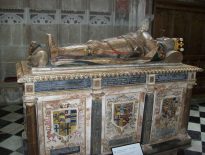William Compton was born in around 1482 and was the only son of Edward Compton of Compton in Warwickshire and his wife, Joan, daughter of Walter Aylworth. He was around 11 years of age when he became the ward of Henry VII following his father’s death in 1493. Henry VII made him a page of Henry, Duke of York, the future Henry VIII. Compton was around nine years older than the king’s son, but they became close friends, and when Henry VIII came to the throne in 1509, the young king kept Compton close by appointing him a gentleman of the king's privy chamber. Compton was made the new king’s groom of the stool. This position made Compton one of Henry VIII’s most intimate and trusted servants, and meant that he controlled access to the king.
Compton was also a Justice of the Peace in several counties, High Sheriff of Worcestershire, Chancellor of Ireland, and Usher of the Black Rod. He also served in the king’s forces in France in 1513, being knighted for his part in the capture of Tournai, and in the Scottish borders in 1523. Henry VIII was generous to those who served him loyally, and Compton received many grants and offices, including being made constable of castles like Sudeley, Kenilworth and Warwick, and being bailiff, keeper, receiver, and steward of various crown lands. His Oxford Dictionary of National Biography biographer, G W Bernard, writes that “By the end of his life he had built up a landed estate, centred on the south midlands, whose gross income in 1524–5 was £1689”.
Elizabeth Amadas, wife of London goldsmith Robert Amadas, claimed that Compton had the responsibility of bringing women to the king in his bedchamber, and some say that he is the one who introduced Elizabeth (Bessie) Blount, mother of the king’s acknowledge illegitimate son, Henry Fitzroy, to the king.
Compton is believed to have been gently spoken, well-liked and kind in his ways. His first wife was Werburga, the daughter of Sir John Brereton, who was also the widow of Sir Francis Cheyney. The couple married in 1512 and went on to have a son and two daughters together. He later went on to marry his second wife, Elizabeth Stonor, in 1522. At around the time of his marriage to Werburga, Compton was linked to a woman who was said to have also been a mistress of Henry VIII, Anne Stafford, Lady Hastings. According to the Spanish ambassador, Compton had procured Anne for the king. Rumours of Anne’s relationship with the king led to her brother, Edward Stafford, Duke of Buckingham, having a public argument with the king and Compton and Lord Hastings removing his wife from court and taking her to a convent. In 1521, Henry VIII sent Compton to arrest the Duke of Buckingham for treason. Buckingham was executed in the same year. Later, Compton himself became involved with Anne, and in 1527 Cardinal Thomas Wolsey cited Compton for living adulterously with Anne. Whatever the truth of the matter, when Compton died in 1528 he did leave money for prayers to be said for Anne’s soul, and he left Anne a life interest in some lands that he owned.In 1526, Compton lost his post of groom of the stool in Cardinal Wolsey’s reform of the privy chamber known as the Eltham Ordinances. He died of sweating sickness on 30th June 1528 at the age of around forty-six, leaving a six-year-old son, Peter.
Written by Charlotte Donovan.
Charlotte Donovan is a 23-year-old, recent BA Hons History Graduate from the University of Hull. Her favourite time period in History is the Tudor period and she has a huge love/interest for Anne Boleyn, Henry VIII and the people of the Tudor court. Charlotte is a writer who is currently halfway through writing her first book. She lives in Hartlepool with her partner where she works at the local college as a Learning Support Assistant, she loves to read/write and also watch TV dramatisations and documentaries of her favourite time periods within history. Charlotte is also a blogger for her own site With love, Charlotte x.
Sources used
Pictures: Compton Wynyates, Wikipedia; William Compton from Showtime's "The Tudors" series.
- “Sir William Compton and Lady Anne Hastings”, Tudor Enthusiast.
- William Compton, Courtier, Wikipedia.
- The rise of Sir William Compton, early Tudor courtier, G W Bernard, The English Historical Review, Volume XCVI, Issue CCCLXXXI, 1 October 1981, Pages 754–777, https://doi.org/10.1093/ehr/XCVI.CCCLXXXI.754
- Bernard, G. (2004-09-23). Compton, Sir William (1482?–1528), courtier. Oxford Dictionary of National Biography. Retrieved 31 Jan. 2018, from http://www.oxforddnb.com/view/10.1093/ref:odnb/9780198614128.001.0001/odnb-9780198614128-e-6039.
- Norton, Elizabeth Bessie Blount: Mistress to Henry VIII, Amberley Publishing.





Here’s a bit of fun and please if anyone can tell me if this is true or not, I would love to hear.
I have visited a property in Northamptonshire on a number of occasions which was connected to the Crompton family and Sir William was mentioned by the guide a few times. This is several years ago. In one of the guide books and the guide going round said the same thing, it says that William was given the rare privilege of being excused for life from having to ever stand in the presence of the King, save doing his job, and was allowed always to sit or remain seated in his presence without having to ask. Is this true?